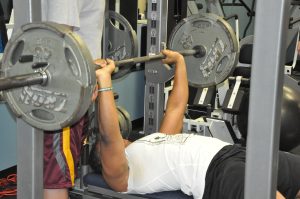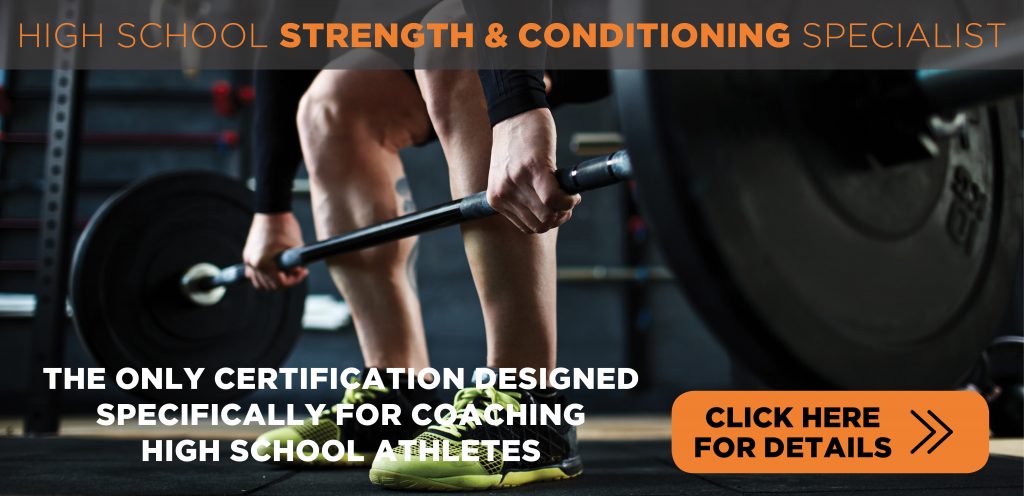Among the many concepts I’ve learned from my experiences as a strength and conditioning coach is: “Don’t get strong wrong.”
Simple and straight to the point. Getting strong wrong is simply loading up athletes on lifts where their mechanics are either poor to begin with, or are being  affected negatively due to the load being too heavy for the athlete to complete a full range of motion. This is where we see half squats, rounded backs on deadlifts, barbells stapling athlete’s chests on the bench press, cleans being pulled in atrociously inefficient manners, etc. The list goes on and on. The implications are numerous and can prove to be quite detrimental for the athlete.
affected negatively due to the load being too heavy for the athlete to complete a full range of motion. This is where we see half squats, rounded backs on deadlifts, barbells stapling athlete’s chests on the bench press, cleans being pulled in atrociously inefficient manners, etc. The list goes on and on. The implications are numerous and can prove to be quite detrimental for the athlete.
This phrase perfectly depicts how poor strength coaches reveal themselves. Unfortunately athletes getting “strong wrong” is occurring more often than not at both the high school, colleges and private facilities across the country.
When an athlete adds weight to a dysfunctional movement, the risk of injury increases exponentially. This is brutally counterproductive considering one of the main responsibilities of a strength and conditioning coach is to prevent injuries. Athletes exposed to months, or years, of dysfunctional strength training may take just as long to properly learn or improve these imperative movements with less weight, and thus are not accomplishing the goals set forth by their strength coach. Time is of the essence when it comes to youth, high school, or collegiate level athletes. Having to take precious time to fix bad habits limits their potential under a strength coach’s watch.
Secondly, the poor motor patterns that are now being learned by athletes can become ingrained in the nervous system, and thus cause a multitude of problems down the road. Joint mobility and flexibility are sacrificed which leads to frequent soft tissue injuries taking place on the practice and playing field. It is assumed that to develop strength throughout the joint’s full range of motion, training must be performed throughout that range. A great example is provided when further dissecting the squat.
Studies show that maximum quad EMG is displayed at 80+ degrees of a squat and that maximum glute EMG is at 90+ degrees. We know that getting parallel to the ground is shown at 90 degrees but with athletes taking short cuts due to heavy weight they are neglecting two enormous muscle groups that are responsible for joint actions that are crucial for sport. Coaches need to remember that these are athletes they are working with, and sports are unpredictable. Taxing the body through its full range of motion with a little less weight, as opposed to overloading the body with a half rep, will better prepare the body for the unknown bends and twists that are associated with sports.
Lastly, what getting strong wrong does to an athlete’s psyche can be just as problematic as the physical repercussions. Coaches that teach or allow improper form, yet record the results, lead kids to believe they are capable of much more than they actually are. These young athletes boast about their weight room numbers (and 40 yard dash times) that are so far from the truth it’s painful to listen to. I’ve listened to dozens of kids talk about their massive squat numbers only to watch them perform half reps. The problem stems from coaches pumping kids up and wanting to show off these big numbers to make it look like they are the best strength coach around for producing such great results. There is a fine line between boosting confidence and creating delusion.
 Smart coaches understand games aren’t won with deceptive bench press numbers, but rather with healthy athletes who are able to play to the best of their ability. At certain levels, the strength coach is around their athletes more often than their position or head coaches. Actions and messages portrayed by the strength coach can often resonate with athletes. Pushing these false standards of success can send out the message that it’s okay to cut corners. Keep the lessons and messages honest. After all, one of the best privileges of being a coach of any kind is seeing an athlete grow to become an honorable human being, not just a standout on the playing field.
Smart coaches understand games aren’t won with deceptive bench press numbers, but rather with healthy athletes who are able to play to the best of their ability. At certain levels, the strength coach is around their athletes more often than their position or head coaches. Actions and messages portrayed by the strength coach can often resonate with athletes. Pushing these false standards of success can send out the message that it’s okay to cut corners. Keep the lessons and messages honest. After all, one of the best privileges of being a coach of any kind is seeing an athlete grow to become an honorable human being, not just a standout on the playing field.
So what can coaches do to prevent the bad habit of getting strong wrong? The easiest answer would be to simply teach athletes proper execution from day one, then begin progressive overload in a safe and efficient manner. For those working with large groups or teams, the ability to perform sound repetitions with a full range of motion simply won’t occur with every athlete. Varying levels of skill and experience are evident at every turn. A coach must focus on the following:
- Performing a well-executed warm-up involving the desired muscles and joints that will be utilized during the specific exercise and session.
- When introducing a new exercise, or covering a more advanced movement, always begin by teaching a bodyweight version, a regressed version, or utilizing teaching aids (dowels, practice bars, etc.) to perform the exercise.
- Progress an exercise or begin to progressively overload in a safe manner when proper range of motion and understanding of the exercise has taken place.
- Possess a coaching repertoire of regressions, modifications, and simple weight room aids to solve any dysfunctional patterns that occur.
Not every athlete will learn or progress at the same pace. Many factors come into play such as age, sex, training status, height, weight, etc. A successful strength coach should always be able to teach proper movement mechanics and make any adjustment necessary to prevent getting strong wrong.
 Joe Powell is an Assistant Strength & Conditioning Coach and Adjust Faculty Member at Central Michigan University. He has experience in a variety of settings including Division I Athletics, private sports performance, high school S & C, personal training and teaching college courses.
Joe Powell is an Assistant Strength & Conditioning Coach and Adjust Faculty Member at Central Michigan University. He has experience in a variety of settings including Division I Athletics, private sports performance, high school S & C, personal training and teaching college courses.
The IYCA High School Strength & Conditioning Specialist Certification is the only certification geared toward training high school aged athletes. Click on the image below to learn more about this unique product.
